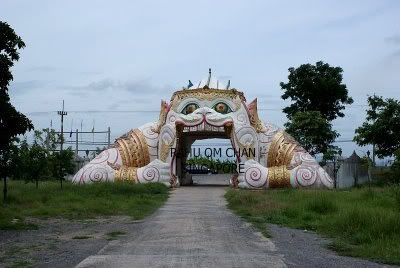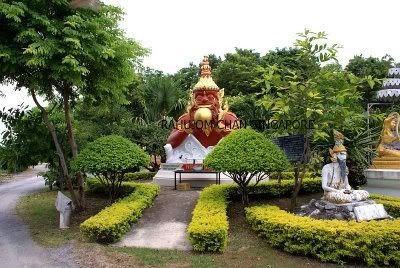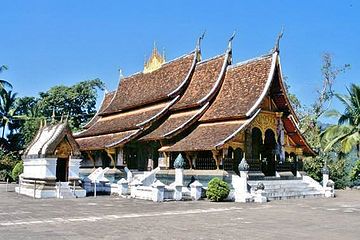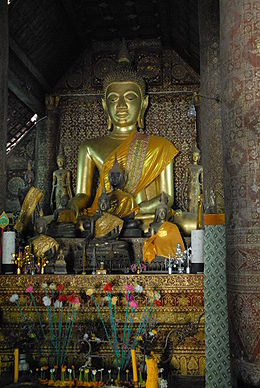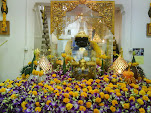Wednesday, 31 December 2008
Saturday, 27 December 2008
Wat Bang Nom Kho

Wat Bang Nom Kho (วัดบางนมโค) is a Buddhist temple in Sena district, Ayutthaya Province, Thailand.
Thursday, 25 December 2008
December
Chinese believed that as an elders, we are not allow to pray, to cry and to do anything for the dead. It's sad~~ really heart breaking and it's like a mission impossible because we are only human and we really missed them .
I wonder some times if he is able to receive the merit we have done for him and I wonder what can I do for him? The only thing i guess i can do for him is to write those mantras for him and pray that all will be well for him in the other world. Dilemma we can be, believing that if we keep on clinging on them ( thinking of them), calling out their names and cried for them, it will slow down their " reincarnation", we know we have to let go, but we just couldn't help it and loses control of ourselves.
We're told that time heals all wounds. That's not entirely true, of course. Time does have the ability to make that acute, searing pain of loss less intense, to make our red-hot emotions less painful. But our feelings of loss and emptiness may never completely go away....
人们常说,人生最痛苦的三件事莫过去少年丧父,中年丧偶,老年丧子。 再辛苦难熬的人生没有比失去自己的至爱更痛苦的事情了。珍惜眼前人!
Tuesday, 23 December 2008
Jataka - Buddha's Former Birth - Pt 2
 The Sama Jataka -Sama is shot by an arrow in his side by King Piliyakka.
The Sama Jataka -Sama is shot by an arrow in his side by King Piliyakka. The Grateful Parrot
The future Buddha was born as Mahasuka, a parrot who lived in a fig tree whose fruit fed him all year long. The God Saka decided to test him., and caused the tree to wither away. The parrot perched on the stump, unperturbed. Saka asked the parrot why he did not fly away. The parrot replied that he could not desert an old friend who had given him so much. On hearing these words, Saka offered him a boon. The parrot asked for his tree to live again, and it sprang back to life.
The Mahasuka Jataka
The Four Friends Jataka
 A story in a Buddhist sutra tells of four animal friends. One day they decided to work out who was the eldest and thus the wisest. To determine their ages, they recalled their first memories of a nearby tree. The elephant remembered it as tall as himself, the monkey as a small tree, and the hare as a sapling. However, the bird remembered it as a seed, which he planted himself. In accordance with this, the animals set themselves in order, with the wisest highest, to show respect and harmony. The future Buddha was the bird and the other animals were attendants and disciples.
A story in a Buddhist sutra tells of four animal friends. One day they decided to work out who was the eldest and thus the wisest. To determine their ages, they recalled their first memories of a nearby tree. The elephant remembered it as tall as himself, the monkey as a small tree, and the hare as a sapling. However, the bird remembered it as a seed, which he planted himself. In accordance with this, the animals set themselves in order, with the wisest highest, to show respect and harmony. The future Buddha was the bird and the other animals were attendants and disciples.
Monday, 22 December 2008
Jataka - Buddha's Former Birth - Pt 1
The future Buddha was born as Bhuridatta, a serpent divinity. He was captured and forced to perform for public entertainment. Despite these and other ignominies and torments of captivity, Bhuridatta remained free of anger, and ultimately regained his freedom.
The Bhuridatta Jataka
The Patient Prince
The Buddha-to-be was born as Prince Candakumara, whose nobility and patience were so great that an official at his father's court grew to hate him. Finally, the official convinced the king to offer his son as sacrifice. The prince faced his death calmly, but at the last moment he was saved by his mother, the queen. her prayers were answered by the god Indra, who interrupted the ceremony.
The Candakumara Jataka
Lifting the Chariot
When he was just a month old, the future Buddha, Prince Temiya, realized that as a ruler he would have to punish his subjects, and so he decided to remain silent and unmoving to avoid hurting other living beings. For 16 years he was tormented by trials to break his resolve. Finally, he was condemned to death. In the chariot that was taking him to his execution, Temiya finally moved: he got out of the chariot and raised it above his head with one hand, in a single action demonstrating his power and merit.
The Temiya Jataka
 Temiya confirms his strenght by lifting a chariot.
Temiya confirms his strenght by lifting a chariot.
Sunday, 21 December 2008
The Parable of Pilgrims
Without further ado, one of the monks took her on his back, carried her across and put her down on dry ground. Then the monks continued on their way. After a while the other monk suddenly burst out :" Surely it is not right to touch a woman. It is against the commandments to have close contact with woman. How can you go against the rules for monk?"... and so on in a steady stream.
The monk who had carried the girl walked along silently, but finally he remarked:" I set her down the river, But you are still carrying her."
Saturday, 20 December 2008
The Paramitas ~ The Perfections
In the Theravada Tradition -
The First Paramita ~Dana in Pali, the paramita of giving, applies to both material and non-material things: service of all kinds, helping others, teaching the Dharma and most importantly, always giving ourselves wholeheartedly to what we are doing right now.
The Second Paramita~Sila (morality) means behaving well at all times, living according to ethical rules or precepts, restraint of the senses and passions, good manners, self discipline, courtesy, consideration and politeness. Sila is also used as a general term for the daily practice of sustained awareness and mindful actions.
The Third Paramita~The Buddha himself admitted that before he was enlightened his heart did not delight in the thought of giving up worldly pleasures. Eventually he realized it was because he had not yet experienced life without them. The practice of renunciation (nekkhama) reduces the pull that sensual experience has on us, leading to relief, freedom and genuine joy.
The Fourth Paramita~The paramita of wisdom ( panna in Pali) means seeing the true nature of things, no longer contaminated by personal bias. With wisdom we can then live in accordance with things as they are, and realize inner peace and the truth.
The Fifth Paramita~Energy (Viriya) encourages us to abandon laziness and procrastination. Fear of not getting what we want can make us unwilling to wholeheartedly give ourselves to life's challenges. Viriya counterects this fearful " I won't" and transforms the heart.
The Sixth Paramita~Patience (Khanti) is considered the means for overcoming anger, ill-will and hatred, maintaining inner peace and tranquillity, and tolerating the intolerable. Patience is one of the most written-about practices in all Buddhism: it calms the passions and, in doing so, diminishes our illusory sense of "I", "me" and "mine" and makes us flexible, tolerant and warm.
The Seventh Paramita~Truthfulness (Sacca) means both honesty with other people and truthfulness with oneself - being honest about what our hearts really long for and courageously pursuing this with the whole of ourselves. if we practise inconsistently, or simply because we desire praise, it will never produce real result.
The Eighth Paramita~To attain any goal we need determination. Resolution (adhitthana) is sometimes called the four determinations: for discernment, for truth, for relinquishment and for calm. This paramita is also concerned with perseverance, the commitment to keep going forward in order to reach freedom and happiness.
The Ninth Paramita~Loving kindness (metta) means "good will" in all our action. If in all circumstances we behave with our hearts uncomplicated by our own desires, sedning out good wishes and love to all being, our actions will be kind and helpful in the deepest sense.
The Tenth Paramita~Equanimity (upekkha) is not at all the same as indifference. it refers to imperturbability, ans is one of the divine states, or brahma viharas. It is also considered to be one of the step toward enlightenment. It is only when the "I" is truly vanquished that there is no fear, and all action then arises from that state of equanimity, fully aware and fully present and thus completely in keeping with the situation.
Meditation~Translated as dhyana in Sanskrit or jhaha in Pali, meditation is a paramita of the Mahayana (Northern) tradition. Meditation simply means to cultivate and develop calm and peaceful awareness, concentration and insight. Eventually, sincere and dedicated practice can lead to the ultimate goal of enlightenment.
Friday, 19 December 2008
Wat Xieng Thong, Laos
Thursday, 18 December 2008
Xieng Kuan (Buddha Park), Vientiane, Laos
Buddha Park, also known as Xieng Khuan (as well as other variations of the spelling) is a sculpture park located 25 km southeast from Vientiane, Laos in a meadow by the Mekong River. It may be referred to as Wat Xieng Khuan (วัดเซียงควน) although the park is not a temple (Wat). The name Xieng Khuan means Spirit City. The park contains over 200 Hindu and Buddhist statues.
The park was built in 1958 by Luang Pu (Venerable Grandfather) Bunleua Sulilat. Luang Pu Bunleua Sulilat was a priest-shaman who integrated Hinduism and Buddhism and later fled from Laos to Thailand after the revolution in 1975. There, he built another sculpture park, Sala Keoku in Nong Khai.
The statues are made of cement and are ornate, and sometimes bizarre, in design. The statues appear to be centuries old, though they are not. There are numerous sculptures of Buddha and characters of Hindu lore. There are also sculptures of humans, gods, animals, and demons. One notable sculpture resembles a giant pumpkin. It has three stories representing three levels - Hell, Earth and Heaven. Visitors can enter through an opening which is a mouth of a 10 ft tall demon head and climb staircases from hell to heaven. Each story contains sculptures depicting the level. At the top, there is a vantage point where the entire park is visible. Another sculpture, an enormous 40 m high reclining Buddha, is also a park attraction.
Admission to the Buddha Park is 5,000 Kip. There's another 2,000 Kip fee for a camera.
You can get to the Buddha Park by tuk-tuk. Most of the drivers around town soliciting tourists can take you there. Expect to pay around 700 Baht.
春府寺庙大佛遭泼强酸
寺庙内正在建缮的1尊大佛,被泼洒强酸,导致佛像受损,预估经济损失约10万铢。
这尊佛像座落在瓦挽拉蒙佛寺正在建设的佛堂之内,投资建造费达到130万铢。可是该佛像却在日前被不法分子泼洒强酸,导致佛像的肩部、左臂等部位大面积被腐蚀,粗略统计经济损失约为10万铢。
瓦挽拉蒙寺庙的方丈表示,该尊大佛受到附近的居民敬仰,寺庙方还在本月5日举行大型诵经法会恭祝皇上圣体安康。
据悉,春武里瓦挽拉蒙寺庙曾在不久前,因在佛塔上塑造前总理塔信等政治人物的头像,招致民主联盟的不满,民盟不仅派人在寺外示威,而且还通过多个渠道给寺庙方面施加压力,最后寺庙方已将塔信等人的头像拆除,才平息了民盟的怒气。
宗教信仰为什么要和政治挂钩呢?如果要发泄心中的不满,也不应该把气出在佛像身上.
本文引用地址:http://www.udnbkk.com/article/2008/1209/article_46147.html
Wednesday, 17 December 2008
Rahu in Pattaya
 There is an article on this temple, unfortunately it's in thai.
There is an article on this temple, unfortunately it's in thai. Source - http://www.pattayadailynews.com/thai/shownews.php?IDNEWS=0000006790
Source - http://www.pattayadailynews.com/thai/shownews.php?IDNEWS=0000006790Tuesday, 16 December 2008
Monks use snake’s blood to exorcise ‘possessed’ playground
The prestigious H.M. the Kings Rachaprachanakroh Foundation school, which caters mainly for Muslim children, was closed for a week while nine Bhuddist and one Chinese monk exorcised the school grounds, spreading snakes’ blood and pigs’ blood around the playing area to drive off the ‘spirits’.
A Muslim ceremony was also performed to persuade the spirits to leave the school. The school’s assistant headmaster, Suda Wonnuha, said the younger children were terrified by the older students irrational behaviour.“We had to cancel all classes for a week,” she said. Kongsak Khoburi, an educational assistant at the school said the ‘crazy behaviour’ started on November 19 when a Year 4 boy ‘displayed worrying behaviour in class’.“He was sitting frozen to his seat, and then he suddenly started screaming,” he said. The boy was taken to the school’s infirmary, but teachers were at first skeptical and thought the students were ‘playing games’. But when disciplinary action didn’t shake the usually boisterous 16-year-old, they realised it was something more sinister.
As the day wore on, the strange behaviour spread to other parts of the school. Groups of primary school girls began dancing ritualistically and chanting in class. Their teachers were unable to control them. By the next morning, students of all ages were doing weird things, and by the Friday, they were uncontrollable. Mr Konsak said there was pandemonium and wild outbursts by children in the playground.The following Monday, the headmaster closed the school for a week.Mr Konsak played down claims that the ‘demons’ were unhappy when a sacred tree near the school was cut down. A spirit house under the tree was destroyed when the tree was cut down to make way for a building development. Mr Konsak said, in Buddist-Thai culture, it is believed that during sampawesi, or when the soul changes condition, it can become open and allow spirits to enter.“Some people believe the spirits have no home and nowhere to go, so they enter the bodies of humans and communicate through them,” he said.
A handful of children playing in the deserted school grounds seemed blissfully unaware of anything untoward occurring. Two girls happily pushed each other around in a make-shift sled, while ten-year-old Panya sat next to Mr Konsak reading his English books. Mr Konsak doesn’t believe his students were possessed by spirits.“I think the children were bored, and were acting this way as some sort of practical joke,” he said.“They have convinced some of their classmates to act this way, and it has escalated from there,” he said.“It has turned into a large scale problem for staff. “But we should understand that a lot of these children come from extremely traumatized backgrounds and many lost family in the tsunami. “Some of them have very different emotional needs to normal children, and many of them come from very poor backgrounds."“They depend on the school for food and housing, and more than 60 students live on campus.”“Most of them returned home when the school was closed, but some stayed, either because they have no family or they have problems at home.”
Source- Phuket Post (2008-12-15 11:22:49)
by Fraser Morton
Monday, 15 December 2008
solar eclipses in 2009
On Wednesday, 2009 July 22, a total eclipse of the Sun is visible from within a narrow corridor that traverses half of Earth. The path of the Moon's umbral shadow begins in India and crosses through Nepal, Bangladesh, Bhutan, Myanmar and China. After leaving mainland Asia, the path crosses Japan's Ryukyu Islands and curves southeast through the Pacific Ocean where the maximum duration of totality reaches 6 min 39 s. A partial eclipse is seen within the much broader path of the Moon's penumbral shadow, which includes most of eastern Asia, Indonesia, and the Pacific Ocean.
So Rahu's in Action again! I guess there will be a big event in Wat Srisathong on that day!
胡
Sunday, 14 December 2008
Saturday, 13 December 2008
Friday, 12 December 2008
walking out of Rahu’s mouth
Thursday, 11 December 2008
Wednesday, 10 December 2008
Tuesday, 9 December 2008
Rahu Cave
Name of Temple - วัดป่ายุบ - Wat Bayup
Location - Mooban 5, Tambon Sattahip, Ampur Saatahip, Chonburi Province
Credits - Richard Barrow & Yeows, Paknam Web
Monday, 8 December 2008
Happy Birthday!
- Longevity Noodle ( Dye with edible black colouring)
- Black Coffee
- Chicken Essence
- Century egg
- Black Biscuit
- Muffin
- Chin Chao
- Black Glutinous Rice with Glutinous Ball
And also a jasmine/Orchid Garland for HIM
Another Legend of Phra Rahu
 It's THE month for Rahu, so why not share some interesting legend of HIM!
It's THE month for Rahu, so why not share some interesting legend of HIM! Sunday, 7 December 2008
Legend of Phra Rahu
It appeared in Attha Katha both in Tim Nidai and Sungyatta Nikai which described the size of Phra Rahu as follow:
"He is 4,800 yoch tall. His chest is 1,200 yoch wide.His forehead is 50 yoch wide and his nose is 30 yoch long," [ yoch is thai linear measure.,1 yoch is 16 kilometers]
In Triphum Katha described the size of Phra Rahu that,
"He is 98,000 yoch tall, measured around his head is 26,000 yoch,his forehead is 300 yoch wide, around his nose is 300 yoch, the space between his eyes and eyebrows is 90 yoch , each of his eyebrow is 200 yoch long, his mouth is 200 yoch wide and 300 yoch deep. Each of his palm is 200 yoch wide and his hand and foot's hair is 30 yoch long"
In thai astrology mentions that Phra Rahu was made up of 12 heads of jack-o-lantern with 12 wind power or the god of storms. He lives in black mansion. He has got bronze body and wears blonde costumes.
He usually lives in clouds and fog, occupies the west and Thai alphabets ย ร ล ว
Another legend in Thai astrology goes that Phra Rahu is the star of wind lives in the northeast with and make friend with Saturn. He is also a couple of balanced-power with the moon. He likes the fire zodiacal signs: Aries, Leo and Sagittarius.
People represent Phra Rahu to number 8 with 12 power which is the part of the power of all the planets power equals 108. When number 8 is lain down in linear it becomes the symbol of infinity .
Source - Mr.Jiaranai Chockmongcholchaichana
Saturday, 6 December 2008
Thai website for Rahu Temple
http://watphrarahoo.com
A set of Rahu Picture


 Since day one when we started to know about Rahu, we were told that 8th December is the day for HIM. But frankly speaking, till date, I have yet to be able to verify what was told to me. I've went thru Thai website on Rahu, went to a few Forum to seek advice from devotees all over the world, in vain.
Since day one when we started to know about Rahu, we were told that 8th December is the day for HIM. But frankly speaking, till date, I have yet to be able to verify what was told to me. I've went thru Thai website on Rahu, went to a few Forum to seek advice from devotees all over the world, in vain. Friday, 5 December 2008
Rahu Cave
Thursday, 4 December 2008
Right Behavior
- The Eight-Fold Noble Path consists of:
|
- Right view means to thoroughly understand the Fourfold truth, to believe in the law of cause and effect, and not to be deceived by appearances and desires. (The law of cause and effect states that: The world is a vast concurrence of causes and effects. Everything happening now is the result of what happened before, and everything which shall happen later is the result of what is happening now. Nothing remains unchanged forever. Therefore, it is an error to become attached to any object, since no object has an enduring reality to it).
- Right thought means the resolution not to cherish desires, not to be greedy, not to be angry, and not to do any harmful deed.
- Right speech means the avoidance of lying words, idle words, abusive words, and double-tongues.
- Right behavior means not to destroy any life, not to steal, and not to commit adultery.
- Right livelihood means to avoid any life that would bring shame.
- Right mindfulness means to maintain a pure and thoughtful mind.
- Right concentration means to hold the mind right and tranquil for its concentration, seeking to realize the mind's pure essence.
- a place of worship
- an edifice devoted to special or exalted purposes
- A holy place not to be tainted by illegal activities and unacceptable behaviors.
Many people tends to forget about the teaching of 8 fold noble path . They tends to do the wrong thing at the wrong time, at the wrong place.
As an Adult, You don't need a God, a Bible, Ten Commandments - or even Five Precepts - to tell you right from wrong. You know when you're doing something you shouldn't be doing and therefore stop it before it gets out of hand and before it's too late. Always bear in mind~~Don't trouble trouble until trouble troubles you!
Wednesday, 26 November 2008
4 bomb attacks rock Bangkok
The number of explosions and injuries was still confusing at press time.
Three explosions were heard outside the outbound passenger terminal of the Suvarnabhumi International Airport at 4:30 am.
The explosion sounds frightened the protesters as police vehicles rushed to the scene. The protesters feared that police would come to violently disperse them. But their leaders managed to calm them down minutes later.
Thai PBS reported that four protesters were injured, two severely in the Suvarnabhumi explosions.
The fourth explosion happened at 6.30am at the Don Muang Airport, where protesters led by the Peoples Alliance for Democracy were rallying.
The figure of injured protesters at Don Muang airport was still confusing.
Channel 3 reported that two were injured but Channel 9 reported that five were injured, two severely.
Channel 3 added that a grenade was also launched at the protesters but it did not explode. And 2 men were injured by bomb shrapnel and one was shot when a group of men hurled two bombs and fired at the 92.75 community radio station for taxi drivers.
Police said the attack happened at 4:30 am.
The station was located inside Vibhavadi Rangsit Soi 3 where dozens of PAD guards attacked taxi drivers Tuesday evening.
A taxi driver, who identified himself as Watcharin, said he and friends were standing at the mouth of the soi and suddenly heard two explosions and the assailants also opened fire at them.
The injured were rushed to the Rajvithi Hospital.
The first explosion occurred on the Dusit Bridget in Bangkok's Dusit district at 2 am Wednesday, police said.
No one was injured in the explosion which caused a small crack at one side of the bridge.
Police found a safety pin of an M26 grenade at the scene. Police quoted eyewitnesses as saying they saw two men on a motorcycle speeding from the direction of the Government House. The pillion rider hurled the bomb to the bridge and they sped away.
Source - By The Nation
**其实早在昨天就有一个在泰国的叔叔告诉我这两天一定有大事情发生,但是因为太忙了,不当一回事.原来消息是那么准确的. 还好亲人都赶在昨天下午回来了,不然真的要担心死了.
Sunday, 23 November 2008
有一天, 这个年轻人听别人说起远方的山上有位得道的高僧,心里不免仰慕,便想去向高僧讨教成佛之道,但他又怕母亲阻拦,便瞒着母亲偷偷从家里出走了。 他一路上跋山涉水,历尽艰辛,终于在山上找到了那位高僧。高僧热情地接待了他。席间,听完他的一番自述,高僧沉默良久。当他向高僧问佛法时,高僧开口道:“你想得道成佛,我可以给你指条道。吃过饭后,你即刻下山,一路到家,但凡遇到有赤脚为你开门的人,这人就是你所谓的佛。你只要悉心侍奉,拜他为师,成佛又有何难?” 年轻人听后大喜,遂叩谢高僧,欣然下山。
第一天,他投宿在一户农家,男主人为他开门时,他仔细看了看,男主人没有赤脚。
第二天,他投宿在一座城市的富有人家,更没有人赤脚为他开门。他不免有些灰心。
第三天,第四天......他一路走来,投宿无数,却一直没有遇到高僧所说的赤脚开门人。他开始对高僧的话产生了怀疑。快到自己家时,他彻底失望了。
日暮时,他没有再投宿,而是连夜赶回家。到家门时已是午夜时分,疲惫至极的他费力地叩动了门环。屋内传来母亲苍老惊悸的声音:“谁呀?”“我,你儿子。”他沮丧地答道。
很快地,门开了,一脸憔悴的母亲大声叫着他的名字把他拉进屋里。就着灯光,母亲流着泪端详他。这时他一低头,蓦地发现母亲竟赤着脚站的冰凉的地上!
刹那间,灵光一闪,他想起高僧的话。他突然什么都明白了。年轻人泪流满面,“扑通”一声跪倒在母亲面前。
**母亲对于我们每个人来说,永远都是伟大的。在你失意,忧伤甚至绝望的时候,千万不要忘记你的母亲会全力的支持你,永远不会放弃你。
Saturday, 22 November 2008
為妹妹輸血的男孩
然而災難再一次降臨在這兩個不幸的孩子身上。妹妹染上重病,需要輸血。但醫院的血液太昂貴,男孩沒有錢支付任何費用,儘管醫院已免去了手術費,但不輸血的話妹妹仍會死去。作為妹妹唯一的親人,男孩的血型和妹妹相符。醫生問男孩是否勇敢,是否有勇氣承受抽血時的疼痛。男孩開始猶豫,10歲的大腦經過一番思考,終於點了點頭。抽血時,男孩安靜地不發出一絲聲響,只是向著鄰床上的妹妹微笑。抽血完畢後,男孩聲音顫抖地問:「醫生,我還能活多長時間?」
醫生正想笑男孩的無知,但轉念間又被男孩的勇敢震撼了:在男孩10歲的大腦中,他認為輸血會失去生命,但他仍然肯輸血給妹妹。在那一瞬間,男孩所做出的決定是付出了一生的勇敢,並下定了死亡的決心。
醫生的手心滲出汗,他緊握著男孩的手說:「放心吧,你不會死的。輸血不會失去生命!」 男孩眼中放出了光彩:「真的?那我還能活多少年?」
醫生微笑著,充滿愛心地說:「你能活到100歲,小伙子,你很健康!」男孩高興得又蹦又跳。他確認自己真的沒事時,就又挽起剛才被抽血的胳膊,昂起頭,鄭重其事地對醫生說:「那就把我的血抽一半給妹妹吧,我們兩個每人活50年!」
心靈絮語
孩子的愛,有時更加純潔和感人。
Thursday, 20 November 2008
 I once know of a group of people who always go to Wat Don Chan, Chiangmai to cook for the Orphans in the temple and donated money on a regular basis. They no longer doing it and it's kind of disappointing.
I once know of a group of people who always go to Wat Don Chan, Chiangmai to cook for the Orphans in the temple and donated money on a regular basis. They no longer doing it and it's kind of disappointing.Lately when I check out the web for this temple, I'm really happy to know that there are foreign volunteers/organization who offer great help to them. Some examples are
- Toys for Thailand - http://www.toysforthailand.org/
- Dreams can come True Foundation - http://www.dcct.org/
- The Chiangmai Family Services - http://www.familycare.org
These organization not only collect donation to improve the facilities ( bed, toilet and shower facility ), they also make sure that there will be sufficient food to feed all the 650 children. They teach the children 4 subjects; art (including painting, handicrafts and jewellery crafting), English, sports (including music and dancing), and photography. They can sell the handicraft and proceed will go to the Temple for future use.
Wednesday, 19 November 2008
Inserting Takrut / Lek Lai inserting ritual
For more than 20 years, Luang Por Koon had chanted and inserted Takrut for devotees but now He had stopped due to poor health. I’ve met someone today with the Takrut under his arm, I was given permission by him to touch it and the feeling is~~ weird, by seeing, you can’t tell that THERE is something inside, but when I started to touch it, I can really feel something inside the arm.
According to him, he did it for blessing of good health. His wife also has one and there was an incident when a doctor was trying to get some blood sample from her, despite several injection, there was no blood ( Believe it or not, she don’t feel the pain at all) and immediately he reminded her that she should try the other side of her hand and within second, blood flows out.
Out of curiosity, I asked him if it’s painful and to my surprised, he said that the pain was during the time when the monk pull the skin of his arm before placing it on a surface, but the moment when he use the piece of wood to "knock" the gold takrut inside his arm, the pain is still bearable and no bloody scenes at all.
These Takrut are very well proven to protect a person from accidents, Metta and as well as Kong Grapan (immunity from weapons). I found some interesting info on Lek lai insertion ritual, which i guess should be similar to what LP Koon did.
"Lek Lai", the mythical Thai-originated magical metal amulet said to possess supernatural powers against evil elements and life-threatening situations. Lek Lai literally means fluid metal in Thai. It usually comes in various shapes, like a capsule, a tiny ball, a turtle, etc. It exists in the crevices of some caves. Legend has it that if one is in possession of a genuine Lek Lai, he would be able to survive three consecutive gun shot, it is said to be a favourite talisman among the Thai enforcement officers.
The monk who perform this ritual would use a ‘sacred wooden hammer’ and a metal hole-puncher to punch a hole through the skin near the upper arm of the devotee concerned.He would then insert the Lek Lai, which usually measures slightly smaller than a "tic-tac", into the devotee’s body through the said hole.
Saturday, 15 November 2008
Friday, 14 November 2008
Wat Phra Yai - Big Buddha

This temple is the home of Koh Samui's most famous landmark the Big Buddha.Visible from several kilometers away and even from the air when arriving on or leaving the island , the 12 meter tall golden image stands proud.
The Buddha statue is called Phra Buddha Kodom, was built in 1972.
Thursday, 13 November 2008
Fasting Buddha
 The young prince Siddharatha left his palace in search of enlightenment and practised for six years such severe austerities and intense mental concentration that his beautiful body withered away to skin and bones. Ultimately he attained enlightenment at the age of thirty five and became known as the Buddha "The enlightened one".
The young prince Siddharatha left his palace in search of enlightenment and practised for six years such severe austerities and intense mental concentration that his beautiful body withered away to skin and bones. Ultimately he attained enlightenment at the age of thirty five and became known as the Buddha "The enlightened one".Monday, 10 November 2008
Trimurti- 三尊天神的合体
- 四面神 - 也称《创造神》
- 毗湿奴 - 《保护神》
- 舌娃 - 《破坏神》
集合了以上3神的力量,就是祂强大的力量,有风,火和阳光的能量:火能把不好的一切燃烧,风能让生物呼吸,而所有生物所不能缺少的必然是阳光。祂的三个脸,第一面代表家庭圆满,感情顺利,第二面带白了稳定的财富,第三面是事业,名利都顺利。
参拜祂的供品~9支红香,一对红蜡烛,9朵红玫瑰(也可以用一串红玫瑰代替),红色的水果,甘蔗汁和鲜奶。千万不可以用荤食和熟食。
大家可以在星期四晚上九点半的时候参拜和许愿。 千万要记得,如果你们对祂做出任何承诺,记得一定要还愿。
Saturday, 8 November 2008
The Trimurti Shrine
.jpg) Trimurti refers to the Trinity of Hindu Gods consisting of Brahma the creator, Vishnu the sustainer and Siva the destroyer, the three most important gods in Hinduism.The deity is a gold statue of a human body with two heads and four arms. The heads are one on top of the other; the lower head has four faces.
Trimurti refers to the Trinity of Hindu Gods consisting of Brahma the creator, Vishnu the sustainer and Siva the destroyer, the three most important gods in Hinduism.The deity is a gold statue of a human body with two heads and four arms. The heads are one on top of the other; the lower head has four faces.There's an open area around the shrine with a ring of seats for worshippers to sit and reflect.
Crafted in classical Indian sculpture with a Thai touch, the statue is a replica of the original from old Ayutthaya.
Legends build upon themselves and as the fame of the shrine grew, so did the flock of faithful. Such is the renown of the shrine that it's sometimes referred to as the Lovers' Shrine.There's an air of peace and serenity around the shrine and the place just has a natural draw for people.
.jpg) The Chao Mae Tuptim shrine is located on the grounds of the Nai Lert Bangkok Hotel (Swissotel) on Wireless Road.
The Chao Mae Tuptim shrine is located on the grounds of the Nai Lert Bangkok Hotel (Swissotel) on Wireless Road. This Shrine is dedicated to Phra Mae Tuptim. A sign at the site indicates that the precise origin of the shrine is unknown. It was likely erected by Nai Lert as a spirit house for the spirit that was believed to reside in the large ficus tree on the spot.
Traditional offerings always included jasmine flowers, incense sticks and lotus buds. However over the years less traditional offerings were given, and now the area around the shrine is occupied by numerous small and large lingams or phallic symbols. As such it is believed the shrine is dedicated to fertility (and good luck).
Tall cylinders of stone (called "lingams") are worshipped as the phallic images of Hindu god Shiva.
It is said that women who pray here in a wish to become fertile for pregnancy, will return if their wish is fulfilled, and place another phallus at the shrine in thanks.
Thais occasionally dangle a tiny wooden phallus from their belt or necklace, for added protection. Modern Thais are familiar with wooden penises which are sold in markets as good luck amulets. Sometimes, a shop or restaurant will display a wooden penis in a discreet location, hoping it will help business.
Thursday, 6 November 2008
Ghost residing in a tree ( ผีต้นไม้ )
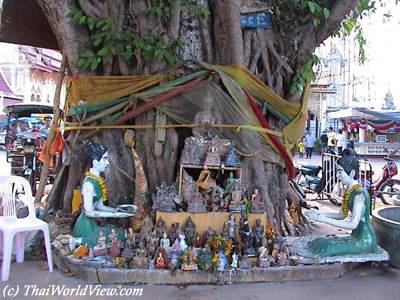 Do you find this familiar? This is a common sight in thai temple. Everywhere in Thailand, some trees are wrapped with a cloth. Especially in temples but also in forests. It means that a spirit inhabits the tree. Of course the tree shall not be cut without warning the spirit in order to let him find another tree.
Do you find this familiar? This is a common sight in thai temple. Everywhere in Thailand, some trees are wrapped with a cloth. Especially in temples but also in forests. It means that a spirit inhabits the tree. Of course the tree shall not be cut without warning the spirit in order to let him find another tree.ผีต้นไม้ or "PHI TON MAI" means "ghosts that reside in tree". They are generally classified into two categories, i.e. benovolent and malevolent spirits. There is often a certain spirit associated to a certain type of tree such as banana tree.
นางไม้ "NANG MAI" is a female spirit inhabiting a tree. Other famous spirits are นางตะเคียน or "NANG TAKIAN" located in hopea trees and นางตานี or "NANG TANEE" located in banana trees.
To protect forests against logging, some monks ordain trees and wrapped them up with a thin orange cloth. Trees were then sacred. For Bouddhist people it was now impossible to harm the trees. Alas sometimes officials used another monk to defrock the trees.
source~thaiworldview.com
Wednesday, 5 November 2008
Renting of Buddha Statues
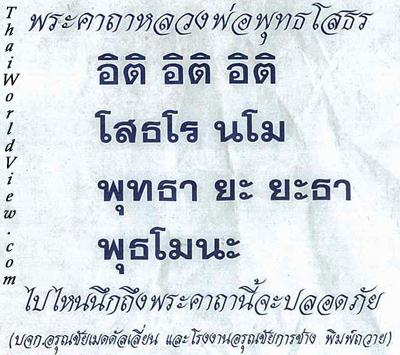
Tuesday, 4 November 2008
Walk On Back~Miracle Healing
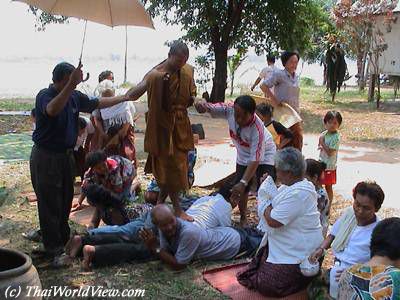 This ceremony starts by a Buddhist sermon in the hall for sermons ("SALA" - ศาลา).
This ceremony starts by a Buddhist sermon in the hall for sermons ("SALA" - ศาลา).This ceremony is supposed to ease back pain for old and middle aged folks.
The monk walks on people back and pour holy water on their back. Before the monk walks on their back, Thai people make a Thai greeting ("WAI" - ไหว้). Thai people make a small donation to thank the monk
source: Thai world view
Monday, 3 November 2008
Holy Money
The image of King RAMA V and Phra Buddhasothorn. I wonder if i keep them in my wallet, will my money will grow??

